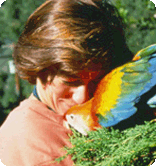Keeping cockatoos outside on coast of Oregon

We are thinking about building an outdoor aviary for our cockatoos and we live on the coast in Oregon. Is it warm enough to keep them outside year round?

Thanks for the question and for your intention to get your Cockatoos outside in the fresh air and light. The answer to this question will come through conversation, because the answer is determined by us finding out what’s right for your birds.
Before you begin aviary construction, ask your avian veterinarian for an assessment of the physical condition of the birds. Examinations, histories and thorough work-ups will help determine their suitability for year-round outdoor activities. I ask my vet to run the same tests she would run on her own beloved birds if faced with the same decision. Then, we analyze the results together. I hope you have a similarly supportive avian vet or that you will cultivate such a relationship as soon as possible for the welfare of your parrots. Perhaps your avian vet already knows your birds and people who have outdoor flights in your area. If you can network with local aviculturists or companion caregivers, their trials and triumphs might be pertinent to the process you follow and the goals you achieve.
We have our Cockatoos outside all year around but central coast CA (3 miles up in the mountains from the coast) is different than Oregon. We enjoy watching them hang upside down in sunlight—crests ablaze, wings out and flapping, they show us luminous colors in full movement. Our Cockatoos have aviaries that are covered on three sides in the back (4’), uncovered wire in the center (14’) and roofed in the front (2’) by the feeding stations. They are long-term outdoor birds in excellent health; daily watchful caregivers are alert to their feeding, preening and activity levels for all times of day and night; perches are correctly sized; enrichments are placed to encourage activity and also to allow for privacy if desired. However, we know that the art of aviary design continues, as does the science.
I knew my Galerita elenora Josserlynn was perfectly healthy when I put her in a flight about 10 years ago. A flyer since fledging, Joss immediately loved her new bigger space outside. Still, I checked her on her first cold nights night by touching the foot she perched on—it was cold. Then I touched the foot her held against her downy chest—warm as toast. She switched feet: the cold one went up, the warm one down. She was and is fine.
Katy McElroy lives in Ohio and keeps her Cockatoos in a combination indoor/outdoor aviary. The indoors is a cinderblock building heated to 33F in the winter, so the water bowls don’t freeze. The doorway to outside is one missing brick. Through this small portal, the ‘Toos enter gloriously large and well-perched outdoor flight. I’ve seen footage of her Cockatoos chewing away at ice-covered perches, and flying in the snow. Importantly, 1) these birds are in amazingly wonderful physical condition and 2) at all times they can choose whether to be inside or outside.
Steve, be sure your birds are physically capable of withstanding its fluctuations. Additionally, you’ll want to watch them carefully so you can postiviely reinforce them when they explore their new habitat. Keep the final perch design flexible—they will show and tell you what they like and how they like it. In an aviary, the larger the better, we can provision our birds with spaces that encourage positive activities such as foraging, swinging, flying, bathing, interaction, privacy and goofing off. An aviary safe from predators that provides escape from harsh weather, access to nice weather, a place where humans and parrots are comfortable as they flock together for meals, playtime, singing and hanging out—this is the aviary to build.
All best,
Phoebe Greene Linden

































